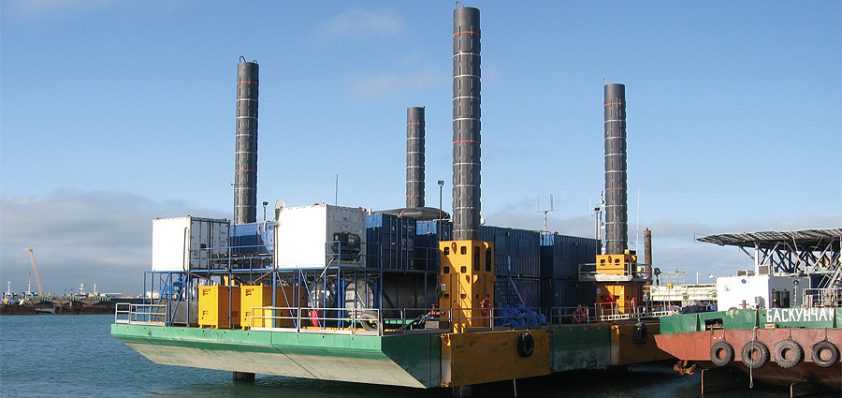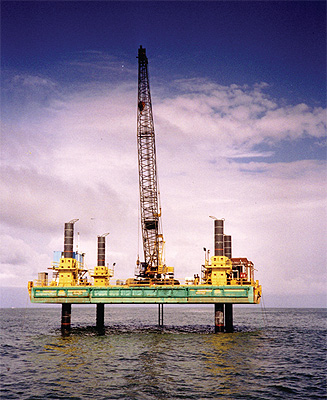
Flexifloat Systems
Float of confidence
Designed over 60 years ago, Flexifloat Systems’ modular floating construction system, called Combifloat, is more popular then ever and the company is continuing to expand.
With a variety of clients in the offshore and marine construction industries, the company’s easy-to-assemble coupling and locking system is suitable for both coastal and inland waters, covering a variety of needs. The Combifloat modular pontoon was designed in response to the fact that marine working environments are never the same, and that equipment requirements vary with local conditions and with the type of job to be performed. With every marine operation there is the challenge of finding the ideal equipment and transporting it to its destination.
Bas de Jong, managing director of Flexifloat Systems explains the company’s capabilities: “We are suppliers of the modular floating construction system, essentially it is like a Lego system that slots together. The product is a rigid steel pontoon with a 15 tonne per square metre deck load; we use it to assemble jetties, bridges, jack up platforms, drilling barges, pipe and cable lay barges. It is ideally suitable for near shore or coastal and inland water operations and it is built under Germanischer Lloyd rules and regulations at our fabrication facilities in the Middle East, Poland and Holland. The system can effectively operate in up to 22 metres water depth.
“The product’s 60-year history shows it is a proven concept and it has been upgraded over the years to meet today’s requirements for use all over the world,” he continues. “We work as a typical equipment supplier to the extent that we design, build, rent, sell or conduct any other option that is commercially attractive to both customers and ourselves.
“The Combifloat modular units can be combined and constructed to nearly any shape and size of floating or self-elevating platform, making it a unique solution for those working in difficult conditions with specific needs. The company has a range of accessories to accompany the main units, changing their purpose to suit requirements. Adding spudwells, spuds and  power units creates self-elevating platforms, while propulsion units, winches, ramps and rakes are also available. Furthermore, bollards, cleats, deck winches, railing, sheaves and fairleads can be added to the floats to aid functionality. The company’s emphasis is on ease, with the product’s high tensile strength and cast steel coupling system being simple and quick to use, while the individual modules are sized to be easily transportable by road, rail or sea. Especially designed so there is no need for special tools, anyone can construct a Combifloat Systems pontoon. The assembly of the structures is easy, the only tools required are a crane, a crowbar and two or three people – it’s really that simple.”
power units creates self-elevating platforms, while propulsion units, winches, ramps and rakes are also available. Furthermore, bollards, cleats, deck winches, railing, sheaves and fairleads can be added to the floats to aid functionality. The company’s emphasis is on ease, with the product’s high tensile strength and cast steel coupling system being simple and quick to use, while the individual modules are sized to be easily transportable by road, rail or sea. Especially designed so there is no need for special tools, anyone can construct a Combifloat Systems pontoon. The assembly of the structures is easy, the only tools required are a crane, a crowbar and two or three people – it’s really that simple.”
Flexifloat Systems is very successful at meeting the individual needs of clients with its extensive experience, high quality product, sound workmanship and fast and reliable service. Bas describes the key strengths that ensure Combifloat is the first choice for customers: “The advantages are that it is a modular system that is so easy to transport, assemble and operate. Because of the modular nature you can get it into any specific project configuration. The pontoon can be used as a jack up platform one day and a jetty the next.
“One of the main selling points of the product is indeed that it is dimensioned for easy handling to transport it to diverse and remote locations with limited or restricted facilities available. We have recently been participating in drilling operations in the swamp areas of south Sudan. This is the type of project where the Combifloat modular system is used to its maximum extend, with a location inaccessible without modular equipment, yet requiring specific stringent parameters to deal with drilling operations. We are also developing our equipment to suit more specialised locations; for example, we are currently extending the length and capacities of our jacking systems so that we can meet the operational requirements in and around
wind farms.”
The aforementioned project in the Sudan is for a drilling operation, where the pontoon equipment was transported by truck over land, and following its assembly in a river, was towed to the harsh environment of the swamp areas. The creation of an artificial lake, completed by the excavators sitting on the pontoons, meant that further Combifloat equipment such as a drilling barge, crane barge, pusher tugs and transport barges could be brought in – an excellent example of the company’s abilities and the flexibility it brings to those in the industry.
Despite its multitude of uses for such a range of practicalities, Bas outlines the challenges that the company will face in the coming years: “The oil price is something that affects our business just like any other. At the moment the price is $60 per barrel, in the years to come I think we again will see that rise to $100 or even $150 per barrel. The uncertainty when this will happen however, together with the present limited availability of financing, will have an affect on our business. At the same time in marine and civil marine construction there are areas in the world where there is still a lot of potential for further growth, so there will definitely be a need for our equipment in years to come. Again however at the moment, because of the credit crunch, it is hard to say when further growth will materialize, but in general I see further development in areas like Russia, Africa, the Middle East, India, certain countries in SE Asia, South America and Australia. In addition we are looking to expand our range of services in the future to reach beyond the realms of steel equipment.”
From oil and gas drilling barges and hoover platforms to crane pontoons and jetties, Combifloat’ successful performance is denoted by its ability to serve a range of purposes with ease and flexibility – accessing locations that others simply can’t reach.
Flexifloat Systems BV
Services Modular Combifloat pontoons